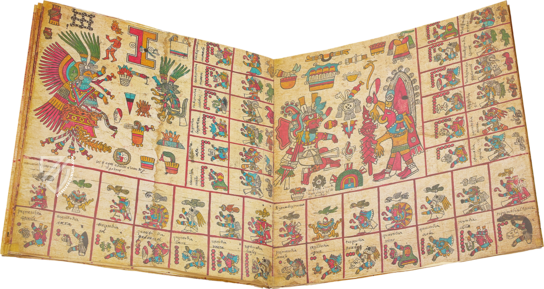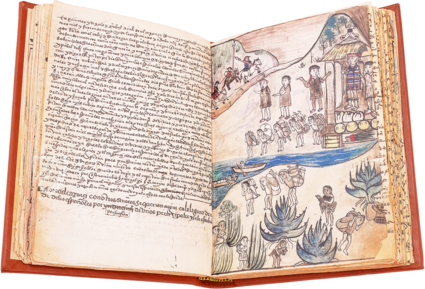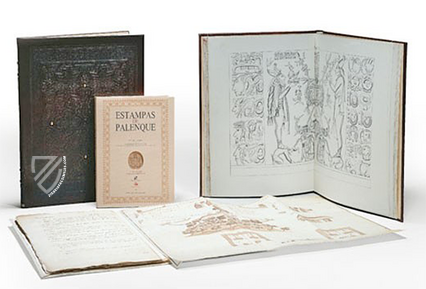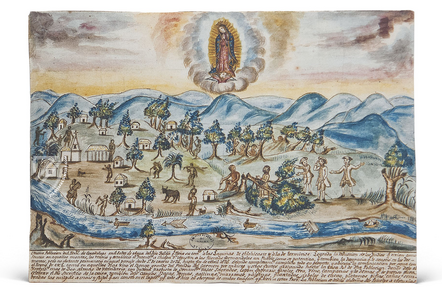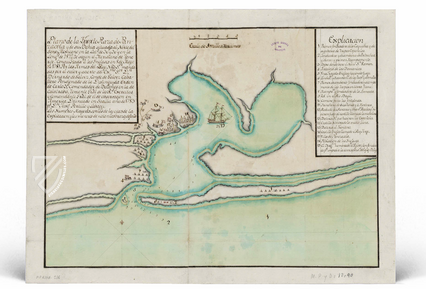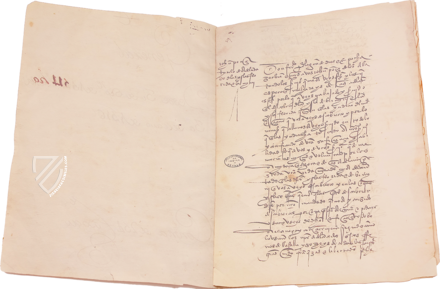Historia en Español de las Indias del Nuovo Mondo
(under 1,000€)
The Historia en Español de las Indias del Nuovo Mondo or “History in Spanish of the Indies of the New World” is a travelogue by the Spanish explorer Álvar Núñez Cabeza de Vaca and reflects his journeys in the Gulf of Mexico and modern Texas. Dated 1537, it is believed to be the earliest manuscript of his Relación y comentarios, which would be first published in 1542 and again in 1555. It stands as one of the most important early geographical and anthropological works concerning the region.
Historia en Español de las Indias del Nuovo Mondo
Unlike most of the famous explorers and conquistadors, the story of Cabeza de Vaca is not one of conquest but one of survival. He was one of only four survivors from the 1527 Narváez Expedition and survived a harrowing trip that went from Florida across the Gulf Coast to the southwestern United States and northern Mexico. The incredible travelogue he wrote after his return, the Relación y comentarios, is considered to be a proto-anthropological work because of the incredibly detailed accounts of the various Native American peoples that he encountered during his eight-year Odyssey. This manuscript dated 1537 is considered to be the original and authoritative version of de Vaca’s historic account.
The Narváez Expedition
Beginning in 1527, an expedition consisting of ca. 600 soldiers and colonists from Spain, Portugal, Greece, and Italy including some married women and Moorish slaves set out for the New World with the objective of establishing settlements and garrisons in Mexico and Florida but met with disaster almost immediately when it was battered by a hurricane after leaving Cuba in 1528. Two ships and hundreds of lives were lost and Narváez ordered that the expedition be split sending 300 men overland while 100 men and ten women departed aboard the remaining ships. The overland expedition suffered from disease, starvation, and indigenous attacks and was eventually reduced to 80 survivors who were enslaved by locals in what is modern day Galveston, Texas. Only four of the original 600 survived their wanderings through the American Southwest before finally reaching Mexico City in 1536, during which times Cabeza de Vaca sometimes served as a folk healer.
Creating the Historic Travelogue
La relación de Álvar Núñez Cabeza de Vaca relates the experiences of Cabeza de Vaca beginning with the shipwreck on Galveston Island in November of 1528 and relates their journey along the coast of Texas as prisoners of the Han and Capoque peoplesfor two years. During this time, he and his companions adopted the customs of their captors and the account records the daily life of numerous peoples as well as the author’s respect for them. It is this compassionate perspective that distinguished Cabeza de Vaca’s travelogue from contemporary accounts and the cultural details include wedding rites, the upbringing of children, and descriptions of their diets. This is the only account of many of the peoples described in the text, possibly because of diseases introduced by the stranded party of Europeans. Nonetheless, this manuscript represents a priceless resource on the peoples and cultures of the New World.
The Life of an Explorer
Born into the minor Castilian nobility ca. 1490, Álvar Núñez Cabeza de Vaca grew up hearing about the exploits of his grandfather Pedro de Vera, a skilled soldier and sailor who led raids against the Moors in North Africa and was a key figure in the conquest of the Canary Islands, specifically Grand Canaria in 1483. He was left with a modest estate to split with his six siblings after the death of his mother in 1509 and as such entered the service of the Duke of Medina Sidonia to pursue his fortunes in Spain’s growing overseas empire. He fought in the Italian Wars between 1511 and 1513 before returning to Spain, where he helped defeat the Revolt of the Comuneros in 1520 and fought against the French invasion of Navarre in the next year.
He finally received an appointment in 1527 to serve as royal treasurer for an expedition led by the conquistador Pánfilo de Narváez. After his harrowing journey, Cabeza de Vaca returned to Spain in 1537, where he wrote his chronicle and attempted to recreate the route of his travels from memory. He once again served the Spanish Crown in what is modern day Argentina, Paraguay, and Uruguay during the years 1540 and 1545. During this time, his humanitarian attitude toward the native population lost him support among Spanish elites who wanted to exploit them for labor and was tried for poor administration but was eventually exonerated before dying in Seville in 1560.
Codicology
- Alternative Titles
- Codex Vindobonensis 5620
- Type
- Manuscript on paper
- Size / Format
- 116 pages / 29.5 × 20.0 cm
- Date
- 1537
- Epochs
- Style
- Language
- Artist / School
- Álvar Núñez Cabeza de Vaca (ca. 1490–1559) (author)
#1 Historia en Español de las Indias del Nuovo Mondo
Language: Spanish
(under 1,000€)
- Treatises / Secular Books
- Apocalypses / Beatus
- Astronomy / Astrology
- Bestiaries
- Bibles / Gospels
- Chronicles / History / Law
- Geography / Maps
- Saints' Lives
- Islam / Oriental
- Judaism / Hebrew
- Single Leaf Collections
- Leonardo da Vinci
- Literature / Poetry
- Liturgical Manuscripts
- Medicine / Botany / Alchemy
- Music
- Mythology / Prophecies
- Psalters
- Other Religious Books
- Games / Hunting
- Private Devotion Books
- Other Genres
- Afghanistan
- Armenia
- Austria
- Belgium
- Belize
- Bosnia and Herzegovina
- China
- Colombia
- Costa Rica
- Croatia
- Cyprus
- Czech Republic
- Denmark
- Egypt
- El Salvador
- Ethiopia
- France
- Germany
- Greece
- Guatemala
- Honduras
- Hungary
- India
- Iran
- Iraq
- Israel
- Italy
- Japan
- Jordan
- Kazakhstan
- Kyrgyzstan
- Lebanon
- Liechtenstein
- Luxembourg
- Mexico
- Morocco
- Netherlands
- Palestine
- Panama
- Peru
- Poland
- Portugal
- Romania
- Russia
- Serbia
- Spain
- Sri Lanka
- Sweden
- Switzerland
- Syria
- Tajikistan
- Turkey
- Turkmenistan
- Ukraine
- United Kingdom
- United States
- Uzbekistan
- Vatican City
- A. Oosthoek, van Holkema & Warendorf
- Aboca Museum
- Ajuntament de Valencia
- Akademie Verlag
- Akademische Druck- u. Verlagsanstalt (ADEVA)
- Aldo Ausilio Editore - Bottega d’Erasmo
- Alecto Historical Editions
- Alkuin Verlag
- Almqvist & Wiksell
- Amilcare Pizzi
- Andreas & Andreas Verlagsbuchhandlung
- Archa 90
- Archiv Verlag
- Archivi Edizioni
- Arnold Verlag
- ARS
- Ars Magna
- ArtCodex
- AyN Ediciones
- Azimuth Editions
- Badenia Verlag
- Bärenreiter-Verlag
- Belser Verlag
- Belser Verlag / WK Wertkontor
- Benziger Verlag
- Bernardinum Wydawnictwo
- BiblioGemma
- Biblioteca Apostolica Vaticana (Vaticanstadt, Vaticanstadt)
- Bibliotheca Palatina Faksimile Verlag
- Bibliotheca Rara
- Boydell & Brewer
- Bramante Edizioni
- Bredius Genootschap
- Brepols Publishers
- British Library
- C. Weckesser
- Caixa Catalunya
- Canesi
- CAPSA, Ars Scriptoria
- Caratzas Brothers, Publishers
- Carus Verlag
- Casamassima Libri
- Centrum Cartographie Verlag GmbH
- Chavane Verlag
- Christian Brandstätter Verlag
- Circulo Cientifico
- Club Bibliófilo Versol
- Club du Livre
- CM Editores
- Collegium Graphicum
- Collezione Apocrifa Da Vinci
- Comissão Nacional para as Comemorações dos Descobrimentos Portugueses
- Coron Verlag
- Corvina
- CTHS
- D. S. Brewer
- Damon
- De Agostini/UTET
- De Nederlandsche Boekhandel
- De Schutter
- Deuschle & Stemmle
- Deutscher Verlag für Kunstwissenschaft
- DIAMM
- Droz
- E. Schreiber Graphische Kunstanstalten
- Ediciones Boreal
- Ediciones Grial
- Ediclube
- Edições Inapa
- Edilan
- Editalia
- Edition Deuschle
- Edition Georg Popp
- Edition Leipzig
- Edition Libri Illustri
- Editiones Reales Sitios S. L.
- Éditions de l'Oiseau Lyre
- Editions Medicina Rara
- Editorial Casariego
- Editorial Mintzoa
- Editrice Antenore
- Editrice Velar
- Edizioni Edison
- Egeria, S.L.
- Eikon Editores
- Electa
- Emery Walker Limited
- Enciclopèdia Catalana
- Eos-Verlag
- Ephesus Publishing
- Ernst Battenberg
- Eugrammia Press
- Extraordinary Editions
- Fackelverlag
- Facsimila Art & Edition
- Facsimile Editions Ltd.
- Facsimilia Art & Edition Ebert KG
- Faksimile Verlag
- Feuermann Verlag
- Folger Shakespeare Library
- Franco Cosimo Panini Editore
- Friedrich Wittig Verlag
- Fundación Hullera Vasco-Leonesa
- G. Braziller
- Gabriele Mazzotta Editore
- Gebr. Mann Verlag
- Gesellschaft für graphische Industrie
- Getty Research Institute
- Giovanni Domenico de Rossi
- Giunti Editore
- Graffiti
- Grafica European Center of Fine Arts
- Guido Pressler
- Guillermo Blazquez
- Gustav Kiepenheuer
- H. N. Abrams
- Harrassowitz
- Harvard University Press
- Helikon
- Hendrickson Publishers
- Henning Oppermann
- Herder Verlag
- Hes & De Graaf Publishers
- Hoepli
- Holbein-Verlag
- Houghton Library
- Hugo Schmidt Verlag
- Idion Verlag
- Il Bulino, edizioni d'arte
- ILte
- Imago
- Insel Verlag
- Insel-Verlag Anton Kippenberger
- Instituto de Estudios Altoaragoneses
- Instituto Nacional de Antropología e Historia
- Introligatornia Budnik Jerzy
- Istituto dell'Enciclopedia Italiana - Treccani
- Istituto Ellenico di Studi Bizantini e Postbizantini
- Istituto Geografico De Agostini
- Istituto Poligrafico e Zecca dello Stato
- Italarte Art Establishments
- Jan Thorbecke Verlag
- Johnson Reprint Corporation
- Josef Stocker
- Josef Stocker-Schmid
- Jugoslavija
- Karl W. Hiersemann
- Kasper Straube
- Kaydeda Ediciones
- Kindler Verlag / Coron Verlag
- Kodansha International Ltd.
- Konrad Kölbl Verlag
- Kurt Wolff Verlag
- La Liberia dello Stato
- La Linea Editrice
- La Meta Editore
- Lambert Schneider
- Landeskreditbank Baden-Württemberg
- Leo S. Olschki
- Les Incunables
- Liber Artis
- Library of Congress
- Libreria Musicale Italiana
- Lichtdruck
- Lito Immagine Editore
- Lumen Artis
- Lund Humphries
- M. Moleiro Editor
- Maison des Sciences de l'homme et de la société de Poitiers
- Manuscriptum
- Martinus Nijhoff
- Maruzen-Yushodo Co. Ltd.
- MASA
- Massada Publishers
- McGraw-Hill
- Metropolitan Museum of Art
- Militos
- Millennium Liber
- Müller & Schindler
- Nahar - Stavit
- Nahar and Steimatzky
- National Library of Wales
- Neri Pozza
- Nova Charta
- Oceanum Verlag
- Odeon
- Orbis Mediaevalis
- Orbis Pictus
- Österreichische Staatsdruckerei
- Oxford University Press
- Pageant Books
- Parzellers Buchverlag
- Patrimonio Ediciones
- Pattloch Verlag
- PIAF
- Pieper Verlag
- Plon-Nourrit et cie
- Poligrafiche Bolis
- Presses Universitaires de Strasbourg
- Prestel Verlag
- Princeton University Press
- Prisma Verlag
- Priuli & Verlucca, editori
- Pro Sport Verlag
- Propyläen Verlag
- Pytheas Books
- Quaternio Verlag Luzern
- Reales Sitios
- Recht-Verlag
- Reichert Verlag
- Reichsdruckerei
- Reprint Verlag
- Riehn & Reusch
- Roberto Vattori Editore
- Rosenkilde and Bagger
- Roxburghe Club
- Salerno Editrice
- Saltellus Press
- Sandoz
- Sarajevo Svjetlost
- Schöck ArtPrint Kft.
- Schulsinger Brothers
- Scolar Press
- Scrinium
- Scripta Maneant
- Scriptorium
- Shazar
- Siloé, arte y bibliofilia
- SISMEL - Edizioni del Galluzzo
- Sociedad Mexicana de Antropología
- Société des Bibliophiles & Iconophiles de Belgique
- Soncin Publishing
- Sorli Ediciones
- Stainer and Bell
- Studer
- Styria Verlag
- Sumptibus Pragopress
- Szegedi Tudomànyegyetem
- Taberna Libraria
- Tarshish Books
- Taschen
- Tempus Libri
- Testimonio Compañía Editorial
- Thames and Hudson
- The Clear Vue Publishing Partnership Limited
- The Facsimile Codex
- The Folio Society
- The Marquess of Normanby
- The Richard III and Yorkist History Trust
- Tip.Le.Co
- TouchArt
- TREC Publishing House
- TRI Publishing Co.
- Trident Editore
- Tuliba Collection
- Typis Regiae Officinae Polygraphicae
- Union Verlag Berlin
- Universidad de Granada
- University of California Press
- University of Chicago Press
- Urs Graf
- Vallecchi
- Van Wijnen
- VCH, Acta Humaniora
- VDI Verlag
- VEB Deutscher Verlag für Musik
- Verlag Anton Pustet / Andreas Verlag
- Verlag Bibliophile Drucke Josef Stocker
- Verlag der Münchner Drucke
- Verlag für Regionalgeschichte
- Verlag Styria
- Vicent Garcia Editores
- W. Turnowski Ltd.
- W. Turnowsky
- Waanders Printers
- Wiener Mechitharisten-Congregation (Wien, Österreich)
- Wissenschaftliche Buchgesellschaft
- Wissenschaftliche Verlagsgesellschaft
- Wydawnictwo Dolnoslaskie
- Xuntanza Editorial
- Zakład Narodowy
- Zollikofer AG



